
Establishments Continuing Traditional Arts/Crafts
The business establishments that have inherited traditional handicraft techniques, influenced are designated as by the Edo culture originated in Musashi no kuni in Saitama City as “Business Establishments Inheriting Traditional Handicraft Techniques”.
Kiritansu
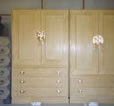
Kiritansu are furniture for storage made of paulownia said to have originally been manufactured in Osaka at the beginning of the Edo period. Paulownia is a “breathable” material, suitable for storing clothes in places like Japan where the humidity is quite high. It is also highly fire resistant and durable.
| Photo | Name | Address | Tel | Website |
|---|---|---|---|---|
 |
Fujimoto Kirizai-ten | 6-1646-4 Mihashi, Nishi Ward |
090-1817-7034 | |
 |
Yokomizo Tansu-ten | 1002 Kamikocho, Omiya Ward |
048-641-6536 |
Mokko(Usukine)
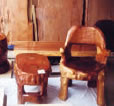
Mokko manufacturing methods originated from the “Ittobori” carving technique which was first used by an artisan involved in building Nikko Tosho-gu Shrine during the Edo period. Mokko manufacturers originally made mortars and pestles for pounding mochi using whole pieces of wood carved with the Ittobori technique. Currently they are manufacturing goods such as desks and chairs as well.
| Photo | Name | Address | Tel | Website |
|---|---|---|---|---|
 |
Kose Mokko | 3-7-11 Honcho, Iwatsuki Ward |
048-756-1489 |
To seihin・kako
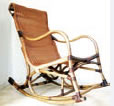
Rattan, a kind of wicker, has been used to make training swords as well as the ridge joints of shrines and temples since the Heian period. In the Edo period, rattan was used as a material for everyday tools. After the Meiji period, it has been utilized to make chairs, baby carriages, and other furniture and products for daily use.
| Photo | Name | Address | Tel | Website |
|---|---|---|---|---|
 |
Hashimoto To-kogei | 4-26-1 Kishicho, Urawa Ward |
048-822-8422 |
Tsumami-kanzashi
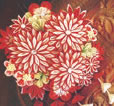
Tsumami-kanzashi (traditional hairpins) are made with “tsumami” workmanship, where thin pieces of cloth are cut into small squares, folded several times with a tweezers and matched together to create a pattern of flowers and birds. The “tsumami” technique for creating flower-petal hairpins was passed on from Kyoto in the early Edo period and has continued to develop since then.
| Photo | Name | Address | Tel | Website |
|---|---|---|---|---|
 |
Edo tsumami-kanzashi Umino | 2-391-4 Kitabukurocho, Omiya Ward |
048-642-0515 |
Hinaningyo-yo zoka
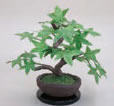
Hinaningyo-yo zoka (artificial flowers) used to be made by artisans in the Asakusa area during the Edo Period as ornaments for the Girl’s Festival. Hinaningyo-yo zoka became popular as common people began to cerebrate Girl’s Day. The artificial flowers are hand-made by cutting cloth, dyeing the peices, arranging them into the desired shape, and binding them with paper and string.
| Photo | Name | Address | Tel | Website |
|---|---|---|---|---|
 |
Okahan | 3-2-8 Daitakubo, Midori Ward |
048-882-8294 |
Gakubuchi
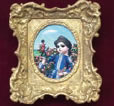
With the introduction of oil-painting from Europe in the Meiji period, manufacturers began full-scale operations creating frames for paintings (gakubuchi).
| Photo | Name | Address | Tel | Website |
|---|---|---|---|---|
 |
Ota Bijutsu-gakubuchi | 4-16-39 Bessho, Minami Ward |
048-861-5318 |
Koto, Shamisen
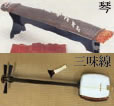
It is said that shamisen first appeard at the end of the Muromachi period. Since the Edo period, the playing of the shamisen has attained a permanent place among traditional Japanese performance arts, together with the development of Joruri puppet theater and kabuki music. The manufacturing of shamisen has increased as traditional Japanese music continues to develop.
| Photo | Name | Address | Tel | Website |
|---|---|---|---|---|
 |
Kikuya Gakki-ten | Lumiere Tokiwa 1F-B, 2-8-8 Tokiwa, Iwatsuki Ward |
048-822-5779 |
Fude
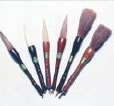
With the emergence of the merchant class in the mid-Edo period, the number of “Terakoya” (temple schools) increased significantly. As a result, fude (ink brushes) became widely used among the common people. The technique of the Edo fude artisans further improved to the point that some of the brushes produced are referred to as “masterpieces”.
| Photo | Name | Address | Tel | Website |
|---|---|---|---|---|
 |
Gamodo | 2-12-20-3 Takasago, Urawa Ward (Magazan Urawa 2F) |
048-822-1105 |
Kendogu
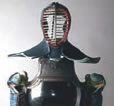
Kendo (the way of the sword) had been passed on through the generations in the samurai class since before the Edo period. Since kendo equipment such as the bamboo sword were invented, kendo has spread among the common people, and the number of artisans had increased as well. The manufacturing process from measurement, to sewing, through assembly is all done by hand.
| Photo | Name | Address | Tel | Website |
|---|---|---|---|---|
 |
Suzuki Kendogu-ten | 4-20-2 Takasago, Urawa Ward |
048-862-4528 |
Kumihimo
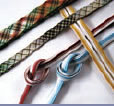
Braided code has been used from a long time ago for Buddhist sutra scrolls and warriors’ armor. It had developed to be widely used for obi, belt and obi band. After the Edo period, the use of braided code expanded from practical to more luxurious and sophisticated ones.
Kumade
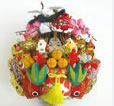
Rake is considered lucky charm as it is “raking luck”. The okame (female mask), crane, pine, oval gold coin, and red sea bream that decorate the rake are also considered lucky charms. The materials are colored and woven one by one manually by artisans.
Daruma
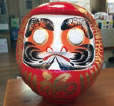
Daruma dolls are made using a special paper-mâché technique in which used paper is pasted into a wooden mold. After adding several layers of whiting and color, a big mustache and fine patterns are drawn to create the Daruma’s face and outfit. The Daruma doll gained popularity among the common people during the Edo period as a lucky charm for protecting one’s family.
| Photo | Name | Address | Tel | Website |
|---|---|---|---|---|
 |
Iwatsuki Seikei | 2258 Sueda, Iwatsuki Ward |
048-798-0945 | |
 |
Taguchi Daruma-ten | 2004 Sueda, Iwatsuki Ward |
048-798-0329 |
Omiya
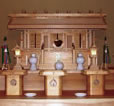
“Omiya” means shrine, and the artisans working for shrines are called “Miyashi”. It is said that the artisans who built Nikko Tosho-gu Shrine settled in this area and thus it is known for its manufacturing of o-fuda (household amulets) and kamidana (household shrines).
Shippo
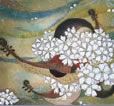
This traditional glazing technique, known as “cloisonné” in the West, involves applying glaze to gold, silver, or bronze and baking it at 800℃ in an oven. The exquisite colors and glazing are compared to the Seven Treasures (Shippo) in the Buddhist sutras. Thus, the technique is refferred to in Japan as “shippo”.
| Photo | Name | Address | Tel | Website |
|---|---|---|---|---|
 |
Katsura Shippo-kenkyujo | 1-6-27 Numakage, Minami Ward |
048-705-0254 | |
 |
Ninomiya Kara-shippo | 3-10-19 Shirahata, Minami Ward |
048-861-6337 |
Chokin
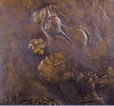
Chokin is a traditional technique by which pictures, patterns and characters are delicately engraved on a metal plate with pine resin. It is used to decorate tea ware, flower vases, frames, obi fasteners, and various accessories giving them elegance and a taste.
| Photo | Name | Address | Tel | Website |
|---|---|---|---|---|
 |
Kawamura Chokoku | 6-19-29 Nishibori, Sakura Ward |
048-862-5329 |
Nihonto
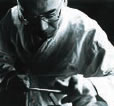
The forging of swords (katana) in Japan has developed into a high art which has been retained to this day. Since ancient times, katana have been made from black iron sand, which is forged, hardened and shaped in the attempt to make them unbreakable, unbending, and razor sharp.
| Photo | Name | Address | Tel | Website |
|---|---|---|---|---|
 |
Arai Nihonto-tanrenjo | 3-17-22 Honcho, Iwatsuki Ward |
048-756-0365 |
Edo Azuma Kushi
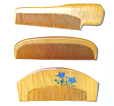
Edo Azuma Kushi combs are made of rare domestic Japanese boxwood and elaborately handcrafted by craftsmen. As they are used, they take on a candy-colored appearance, and if they are not neglected, they will last long enough to be used for generations to come.
| Photo | Name | Address | Tel | Website |
|---|---|---|---|---|
 |
Hiroshima Tsugegushi-ten | 5-10-9 Suzuya, Chuo Ward |
048-711-8007 |
Goseki Hariko
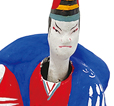
These local toys were made in Goseki, Sakura-ku, and include daruma dolls, dolls, and masks. The dolls are characterized by the way they shake their heads vertically. Hariko are made of water-absorbed washi paper (Japanese paper) that is pasted onto a wooden mold, dried, pulled out of the mold, formed and colored, with a hollow inside.
| Photo | Name | Address | Tel | Website |
|---|---|---|---|---|
 |
Goseki Hariko Yamazaki Rakuzan | 382 Okuboryoke, Sakura Ward |
048-858-6770 |





















